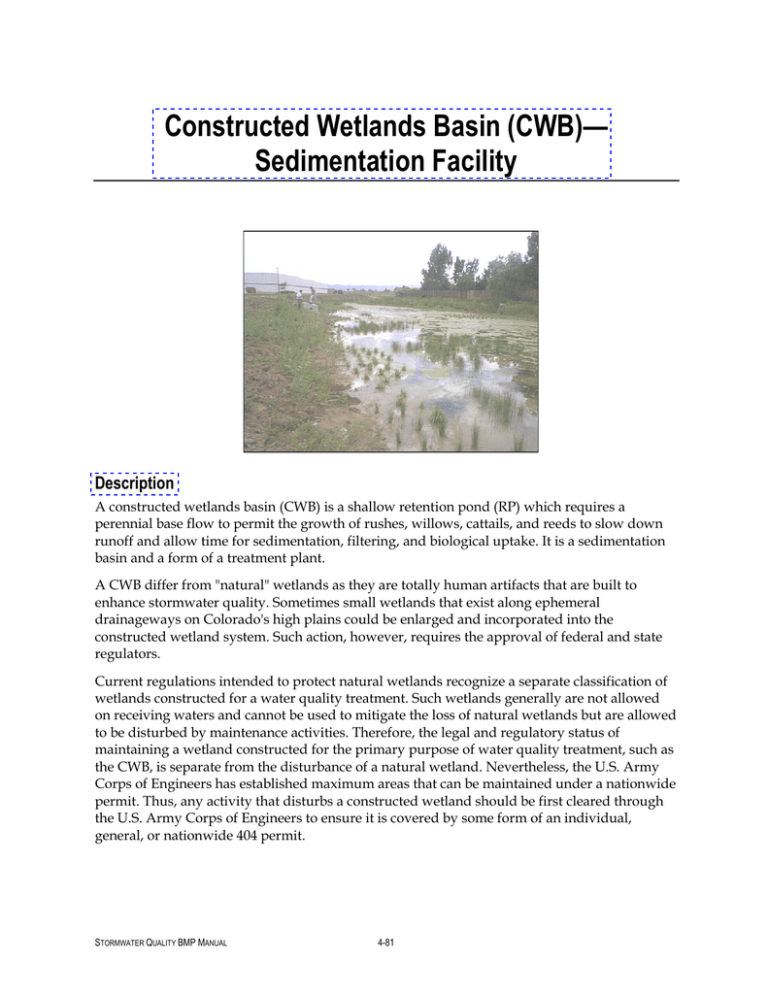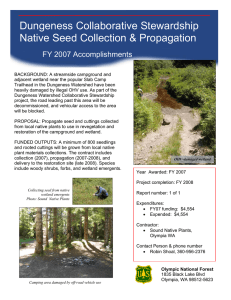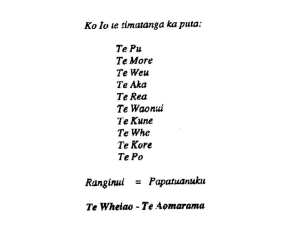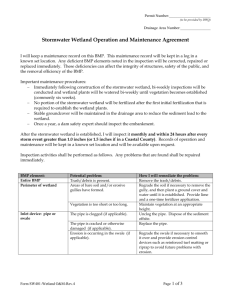Constructed Wetlands Basin (CWB
advertisement

Constructed Wetlands Basin (CWB)— Sedimentation Facility Description A constructed wetlands basin (CWB) is a shallow retention pond (RP) which requires a perennial base flow to permit the growth of rushes, willows, cattails, and reeds to slow down runoff and allow time for sedimentation, filtering, and biological uptake. It is a sedimentation basin and a form of a treatment plant. A CWB differ from "natural" wetlands as they are totally human artifacts that are built to enhance stormwater quality. Sometimes small wetlands that exist along ephemeral drainageways on Colorado's high plains could be enlarged and incorporated into the constructed wetland system. Such action, however, requires the approval of federal and state regulators. Current regulations intended to protect natural wetlands recognize a separate classification of wetlands constructed for a water quality treatment. Such wetlands generally are not allowed on receiving waters and cannot be used to mitigate the loss of natural wetlands but are allowed to be disturbed by maintenance activities. Therefore, the legal and regulatory status of maintaining a wetland constructed for the primary purpose of water quality treatment, such as the CWB, is separate from the disturbance of a natural wetland. Nevertheless, the U.S. Army Corps of Engineers has established maximum areas that can be maintained under a nationwide permit. Thus, any activity that disturbs a constructed wetland should be first cleared through the U.S. Army Corps of Engineers to ensure it is covered by some form of an individual, general, or nationwide 404 permit. STORMWATER QUALITY BMP MANUAL 4-81 General Application A CWB can be used as a followup structural BMP in a watershed, or as a stand-alone onsite facility if the owner provides sufficient water to sustain the wetland. Flood control storage can be provided above the CWB’s water quality capture volume (WQCV) pool to act as a multiuse facility. CWB requires a net influx of water to maintain its vegetation and microorganisms. A complete water budget analysis is necessary to ensure the adequacy of the base flow. Advantages/Disadvantages General A CWB offers several potential advantages, such as natural aesthetic qualities, wildlife habitat, erosion control, and pollutant removal. It can also provide an effective followup treatment to onsite and source control BMPs that rely upon settling of larger sediment particles. In other words, it offers yet another effective structural BMP for larger tributary catchments. The primary drawback of the CWB is the need for a continuous base flow to ensure viable wetland growth. In addition, silt and scum can accumulate and unless properly designed and built, can be flushed out during larger storms. In addition, in order to maintain a healthy wetland growth, the surcharge depth for WQCV above the permanent water surface cannot exceed 2 feet. Along with routine good housekeeping maintenance, occasional “mucking out” will be required when sediment accumulations become too large and affect performance. Periodic sediment removal is also needed for proper distribution of growth zones and of water movement within the wetland. Physical Site Suitability A perennial base flow is needed to sustain a wetland, and should be determined using a water budget analysis. Loamy soils are needed in a wetland bottom to permit plants to take root. Exfiltration through a wetland bottom cannot be relied upon because the bottom is either covered by soils of low permeability or because the groundwater is higher than the wetland's bottom. Also, wetland basins require a near-zero longitudinal slope, which can be provided using embankments. Pollutant Removal See Table ND-2 for estimated ranges in pollutant removals. Reported removal efficiencies of constructed wetlands vary significantly. Primary variables influencing removal efficiencies include design, influent concentrations, hydrology, soils, climate, and maintenance. With periodic sediment removal and routine maintenance, removal efficiencies for sediments, organic matter, and metals can be moderate to high; for phosphorous, low to high; and for nitrogen, zero to moderate. Pollutants are removed primarily through sedimentation and entrapment, with some of the removal occurring through biological uptake by vegetation and microorganisms. Without a continuous dry-weather base flow, salts, and algae can concentrate STORMWATER QUALITY BMP MANUAL 4-82 in the water column and can be released into the receiving water in higher levels at the beginning of a storm event as they are washed out. Researchers still do not agree whether routine aquatic plant harvesting affects pollutant removals significantly. Until research demonstrates and quantifies these effects, periodic harvesting for the general upkeep of wetland, and not routine harvesting of aquatic plants, is recommended. Design Considerations Figure CWB-1 illustrates an idealized CWB. An analysis of the water budget is needed to show the net inflow of water is sufficient to meet all the projected losses (such as evaporation, evapotranspiration, and seepage for each season of operation). Insufficient inflow can cause the wetland to become saline or to die off. Design Procedure and Criteria The following steps outline the design procedure for a CWB. 1. Basin Surcharge Storage Volume Provide a surcharge storage volume equal to the WQCV based on a 24-hour drain time, above the lowest outlet (i.e., perforation) in the basin. A. Determine the WQCV using the tributary catchments percent imperviousness. Account for the effects of DCIA, if any, on Effective Imperviousness. Using Figure ND-1, determine the reduction in impervious area to use with WQCV calculations. B. Find the Required Storage Surcharge Volume (watershed inches of runoff) above the permanent pool level. Determine the Required Storage (watershed inches of runoff) using Figure CWB-2, based on the constructed wetland basin 24-hour drain time. Calculate the Surcharge Volume in acre-feet as follows: æ WQCV ö ÷ ∗ Area è 12 ø Design Surcharge Volume = ç In which: Area = The tributary drainage area tributary to the CWB (acres). 2. Wetland Pond Depth and Volume STORMWATER QUALITY BMP MANUAL The volume of the permanent wetland pool shall be no less than 75 percent of the WQCV found in Step 1. 4-83 Proper distribution of wetland habitat is needed to establish a diverse ecology. Distribute pond area in accordance with the following: TABLE 1 Components Percent of Permanent Pool Surface Area Water Design Depth Forebay, outlet and free water surface areas 30% to 50% 2 to 4 feet deep Wetland zones with emergent vegetation 50% to 70% 6 to 12 inches deep* *One-third to one-half of this zone should be 6 inches deep. 3. Depth of Surcharge WQCV The surcharge depth of the WQCV above the permanent pool’s water surface shall not exceed 2.0 feet. 4. Outlet Works Provide outlet works that limit WQCV depth to 2 feet or less. Use a water quality outlet that is capable of releasing the WQCV in no less than a 24-hour period. Refer to the Structural Details section for schematics pertaining to structure geometry: grates, trash racks, and screens; outlet type: orifice plate or perforated riser pipe; cutoff collar size and location; and all other necessary components. For a perforated outlet, use Figure CWB-3 to calculate the required area per row based on WQCV and the depth of perforations at the outlet. See the tructural Details section to determine the appropriate perforation geometry and number of rows (The lowest perforations should be set at the water surface elevation of the outlet pool). The total outlet area can then be calculated by multiplying the area per row by the number of rows. 5. Trash Rack STORMWATER QUALITY BMP MANUAL Provide a trash rack of sufficient size to prevent clogging of the primary water quality outlet. Size the rack so as not to interfere with the hydraulic capacity of the outlet. Using the total outlet area and the selected perforation diameter (or height), Figures 6, 6a or 7 in the Structural Details section will help to determine the minimum open area required for the trash rack. If a perforated vertical plate or riser is used as suggested in the Manual, use onehalf of the total outlet area to calculate the trash rack’s size. This accounts for the variable inundation of the outlet orifices. Figures 6 and 6a were developed as suggested standardized outlet designs for smaller sites. 4-84 6. Basin Use Determine if flood storage or other uses will be provided for above the wetland surcharge storage or in an upstream facility. Design for combined uses when they are to be provided for. 7. Basin Shape Shape the pond with a gradual expansion from the inlet and a gradual contraction to the outlet, thereby limiting short circuiting. The basin length to width ratio between the inlet and outlet should be 2:1 to 4:1 with 3:1 recommended. It may be necessary to modify the inlet and outlet point through the use of pipes, swales, or channels, to accomplish this. 8. Basin Side Slopes Basin side slopes are to be stable and gentle to facilitate maintenance and access needs. Side slopes should be no steeper than 3:1, preferably 4:1 or flatter. 9. Base Flow A net influx of water must be available throughout the year that exceeds all of the losses. The following equation and parameters can be used to estimate the net quantity of base flow available at a site: Qnet = QInflow − QEvap − QSeepage − QE .T . Where: 10. Inlet/Outlet Protection STORMWATER QUALITY BMP MANUAL QNet = Net quantity of base flow (acre-ft/year) QInflow = Estimated base flow (acre-ft/year) (Estimate by seasonal measurements and/or comparison to similar watersheds) QEvap = Loss attributed to evaporation less the precipitation (acre-ft/year) (Computed for average water surface) QSeepage = Loss (or gain) attributed to seepage to groundwater (acre-ft/year) QE.T. = Loss attributed to plant evapotranspiration (computed for average plant area above water surface, not including the water surface) Provide a means to dissipate flow energy entering the basin to limit sediment resuspension. Inlets should correspond to the drop-structure criteria in the Design Criteria section of the City of Colorado Springs and El Paso County Drainage Criteria Manual. Outlets should be placed in an offbay that is at least 3 feet deep. The outlet should be protected from clogging by a skimmer shield that starts at the bottom of the permanent pool and extends above the maximum capture volume depth. Provide for a trash rack also. 4-85 11. Forebay Design Provide the opportunity for larger particles to settle out in an area that has a solid driving surface bottom for vehicles to facilitate sediment removal. The forebay volume of the permanent pool should be 5 to 10 percent of the design water quality capture volume. 12. Vegetation Cattails, sedges, reeds, and wetland grasses should be planted in the wetland bottom. Berms and side-sloping areas should be planted with native or irrigated turf-forming grasses. Initial establishment of the wetlands requires control of the water depth. After planting wetland species, the permanent pool should be kept at 3 to 4 inches to allow growth and to help establish the plants, after which the pool should be raised to its final operating level. Professionals experienced in design of wetlands, including plant selection/diversity/location and scheduling of plantings, need to be involved in the planning, design and construction phases. 13. Maintenance Access Provide vehicle access to the forebay and outlet area for maintenance and removal of bottom sediments. Maximum grades should not exceed 10 percent, and a stabilized, all-weather driving surface needs to be provided. Design Example Design forms that provide a means of documenting the design procedure are included in the Design Forms section. A completed form follows as a design example. Maintenance Recommendations To achieve and maintain a healthy wetland for water quality enhancement, the proper depth and the spatial distribution of growth zones must be maintained. Table CWB-1 summarizes suggested activities and their frequencies to maintain an operational wetland. TABLE CWB-1 Constructed Wetlands Maintenance Considerations Required Action Maintenance Objective Frequency of Action Lawn mowing and lawn care Mow occasionally to limit unwanted vegetation. Maintain irrigated turf grass at 2 to 4 inches tall and nonirrigated native turf grasses at 4 to 6 inches. Routine – depending on aesthetic requirements. Debris and litter removal Remove debris and litter from entire pond to minimize outlet clogging and aesthetics. Include removal of floatable material from the pond's surface. Routine – including just before annual storm seasons (that is, in April and May) and following significant rainfall events. STORMWATER QUALITY BMP MANUAL 4-86 TABLE CWB-1 Constructed Wetlands Maintenance Considerations Required Action Maintenance Objective Frequency of Action Sediment removal Remove accumulated sediment and muck along with much of the wetland growth. Reestablish growth zone depths and spatial distribution. Revegetate with original wetland species. Nonroutine – every 10 to 20 years as needed by inspection if no construction activities take place in the tributary watershed. More often if they do. Expect to clean out forebay every 1 to 5 years. Aquatic plant harvesting Cut and remove plants growing in wetland (such as cattails and reeds) to remove nutrients permanently with manual work or specialized machinery. Nonroutine until further evidence indicates such action would provide significant nutrient removal. In the meantime, perform this task once every 5 years or less frequently as needed to clean the wetland zone out. Inspections Observe inlet and outlet works for operability. Verify the structural integrity of all structural elements, slopes, and embankments. Routine – at least once a year, preferably once during one rainfall event resulting in runoff. STORMWATER QUALITY BMP MANUAL 4-87 Side Slop es No Steep er Th an 3:1 Side Slo pe No Stee per than 3:1 Emban kment Forebay Ou tlet Works Spillway Depth Variat ion Legend Ma inten ance Acce ss Innundated 6 " below p ermanent p ool PLAN Innundated to 12" belo w permanent pool NOT TO SCALE Permanent W. S. Inundate d 2' to 4' below permanent pool Flow Baffle Struct ure Spillway Crest Flow Out let Works 2' to 4' 6" 12" Cutoff Collar PROFILE NOT TO SCALE Provide Bottom Drain FIGURE CWB-1 Plan and Profile of a Constructed Wetland Basin Sedimentation Facility STORMWATER QUALITY BMP MANUAL 4-88 0.50 0.45 Extended Detention Basin 40-hour Drain Time WQCV (watershed inches) 0.40 0.35 WQCV=a*(0.91i 3 -1.19i 2 +0.78i) 0.30 6-hr drain time 12-hr drain time 24-hr drain time 40-hr drain time 0.25 Constructed Wetland Basin 24-hour Drain Time a = 0.7 a = 0.8 a = 0.9 a = 1.0 0.20 0.15 Retention Pond, Porous Pavement Detention and Porous Landscape Detention 12-hour Drain Time 0.10 0.05 0.00 0 0.1 0.2 0.3 0.4 0.5 0.6 0.7 0.8 0.9 Total Imperviousness Ratio (i = I wq /100 ) FIGURE CWB-2 Water Quality Capture Volume (WQCV), 80th Percentile Runoff Event STORMWATER QUALITY BMP MANUAL 4-89 1 ft ft 5 ft 0 2. 0 1. 1. D W Qh = M ax im um fo ra 4. 0 ft CW B = 3. 0 ft EXAMPLE: D WQ = 2.5 ft WQCV = 2.1 ACRE - FEET SOLUTION: REQUIRED AREA PER ROW = 6.0 IN 2 EQUATION: a= WQCV K24 K = 0.012DWQ 2+ 0.14D WQ - 0.06 NOTE: D < 2.0 FT FOR A CONSTRUCTED WETLAND BASIN (CWB) M in im um De pt h IN WHICH, Required Area per Row,a (in. 2 ) Source: Douglas County Storm Drainage and Technical Criteria, 1986. FIGURE CWB-3 Water Quality Outlet Sizing: Constructed Wetland Basin With a 24-Hour Drain Time of The Capture Volume S TORMWATER Q UALITY B MP M ANUAL 4-90 Design Procedure Form: Constructed Wetland Basin (CWB) - Sedimentation Facility Sheet 1 of 3 Designer: Company: Date: October 2, 2000 Project: Location: 1. Basin Storage Volume A) Tributary Area's Imperviousness Ratio (i = Ia / 100 ) B) Contributing Watershed Area (Area) C) Water Quality Capture Volume (WQCV) 3 2 (WQCV =0.9 * (0.91 * I - 1.19 * I + 0.78 * I)) D) Design Volume: Vol = (WQCV / 12) * Area Ia = i= 50.00 0.50 % Area = 50.00 acres WQCV = 0.19 watershed inches Vol = 0.77 acre-feet 2. Wetland Pond Volume, Depth, and Water Surface Area Calculated Required Minimums: VolPool > 0.58 acre-feet WS Area = 0.39 acres, estimated A) Minimum Permanent Pool: VolPool > 0.75 * Vol Enter the Actual Design Values: VolPool > 0.60 acre-feet, final design 0.40 acres, final design WS Area = B) Forebay (Volume > 0.05 * Vol in 1D) Depth minimum = 2.5', maximum = 4.0' Volume= Depth= Area= 0.04 3.50 0.011 acre-feet feet acres, % = 2.86% C) Outlet Pool (Area > 0.06 * Design WS Area) Depth minimum = 2.5', maximum = 4.0' Depth= Area= 3.00 0.025 feet acres, % = 6.25% D) Wetland Zones with Emergent Vegetation ( 6" to 12" deep) (Area = 50% to 70% of Design WS Area) Depth= Area= 0.75 0.220 feet acres, % = 55.00% E) Free Water Surface Areas ( 2' to 4' deep) (Area = 30% to 50% of Design WS Area) Depth= Area= 3.50 0.144 feet acres, % = Z= 4.00 3 Average Side Slope Above Water Surface (3:1 or flatter) A) Depth of WQCV Surcharge (above permanent pool, 2' max.) 1.8 feet 4. Outlet Works X A) Outlet Type (Check One) Orifice Plate Perforated Riser Pipe Other: B) Depth at Outlet Above Lowest Perforation (H, 2' max.) H= 1.80 feet C) Required Maximum Outlet Area per Row, (Ao) Ao = 3.35 square inches D) Perforation Dimensions (Refer to Figure 5 in W.Q. Str. Det.): (Enter one only): i) Circular Perforation Diameter OR ii) 2" Height Rectangular Perforation Width D= W= 1.63 inches, OR inches STORMWATER QUALITY BMP MANUAL 4-91 35.89% 100.00% Design Procedure Form: Constructed Wetland Basin (CWB) - Sedimentation Facility Sheet 2 of 3 Designer: Company: October 2, 2000 Date: Project: Location: E) Number of Columns (nc) nc = 1 Number F) Actual Design Outlet Area per Row (Ao) Ao = 3.26 G) Number of Rows (nr) nr = 5 H) Total Outlet Area (Aot) Aot = 17.60 square inches At = 528.89 square inches square inches Number 5. Trash Rack A) Needed Open Area: At = 0.5 * (UDFCD Vol. 3 Figure 7 Value) * Aot B) Type of Outlet Opening (Check One) X < 2" Diameter Round 2" High Rectangular Other: C) For 2", or Smaller, Round Opening (Ref.: Figure 6a): i) Width of Trash Rack and Concrete Opening (W conc) from UDFCD Vol. 3, Table 6a-1 ii) Height of Trash Rack Screen (HTR) W conc = inches HTR = inches iii) Type of Screen (Based on Depth H), Describe if "Other" S.S. #93 VEE Wire (US Filter) Other: iv) Screen Opening Slot Dimension, Describe if "Other" 0.139" (US Filter) Other: v) Spacing of Support Rod (O.C.) Type and Size of Support Rod (Ref.: UDFCD Vol. 3 Table 6a-2) inches vi) Type and Size of Holding Frame (Ref.: UDFCD Vol. 3 Table 6a-2) D) For 2" High Rectangular Opening (Refer to UDFCD Vol. 3 Figure 6b): I) Width of Rectangular Opening (W) W= 1.63 inches ii) Width of Perforated Plate Opening (W conc = W + 12") W conc = 13.63 inches iii) Width of Trashrack Opening (W opening) from Table 6b-1 W opening = 24.0 inches HTR = 46 inches iv) Height of Trash Rack Screen (HTR) v) Type of Screen (based on depth H) (Describe if "Other") vi) Cross-bar Spacing (Based on Table 6b-1, Klemp Grating). Describe if "Other" STORMWATER QUALITY BMP MANUAL TM KPP 4-92 TM X Klemp Other: 2 inches Other: KPP Series Aluminum Design Procedure Form: Constructed Wetland Basin (CWB) - Sedimentation Facility Sheet 3 of 3 Designer: Company: October 2, 2000 Date: Project: Location: TM vii) Minimum Bearing Bar Size (Klemp Series, Table 6a-2) (Based on depth of WQCV surcharge) 1.00 in. x 3/16 in. X 6. Basin Use for Quantity Controls (Check one or describe if "Other") Detention within the facility Detention upstream of the facility Other: 7. Basin length to width ratio 3.00 (L/W) 8. Basin Side Slopes (Z, horizontal distance per unit vertical) 4.00 (horizontal/vertical) 9 Annual/Seasonal Water Balance (Qnet has to be positive) Qinflow 362.00 acre-feet/year Qevap 1.40 acre-feet/year Qseepage 2.80 acre-feet/year QE.T. 1.50 acre-feet/year Qnet 356.30 acre-feet/year 10 Vegetation (Check the method being applied or describe) X X Native Grass Irrigated Turf Grass Side Slopes Wetland Species in Pool* Other: *Describe Species Density and Mixl. Notes: STORMWATER QUALITY BMP MANUAL 4-93






